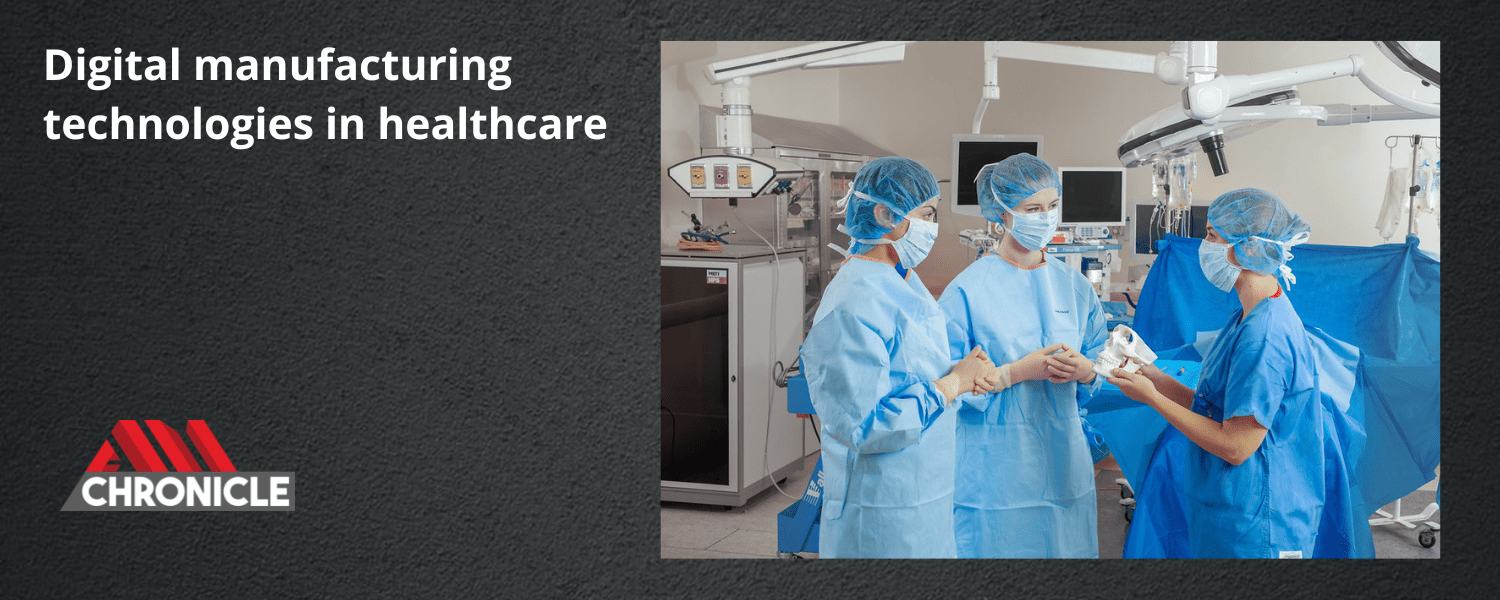The AM Chronicle article focuses on value creation and value proposition by digital manufacturing in the healthcare sector.
Digital Manufacturing Technologies are considered the key drivers for the next generation of engineering systems. These technologies have impacted various industries, including aerospace, manufacturing, space-tech, and agriculture. The healthcare sector is an early adaptor of digital manufacturing technologies, and there have been several innovations in digital manufacturing, 3D printing and software specifically for the medical industry. 3D printing is an essential digital technology currently used for various applications in healthcare. Additionally, various new start-ups have been developed worldwide focused on using 3D printing for value addition in healthcare.
Business Models for Digital Healthcare
The fundamental classification of the digital manufacturing services in healthcare is based on the services they provide to various stakeholders. This includes 3D printing services, industrial machines, healthcare materials and softwares. The design and analysis services providers are also an essential part of digital manufacturing technologies facility for healthcare.
The more accurate classification mainly includes three types of business models that are generative, facilitative, and selective services. The main aim of the generative services is to generate computer-aided design (CAD) models for patients. The companies involved in the generative services have expertise in developing patient-specific and high-quality CAD models for 3D printing. Design factors such as materials selection, design for additive manufacturing (DfAM), and others are the core-competencies of such companies. The second type of company is facilitative services responsible for printing the CAD models. These companies have specialized machines that can print various materials at medical standards. The third type of service is selective services. The companies that work in particular services offer a wide range of models to patients or doctors. The patient or the doctor can select the pre-developed models according to the medical requirement.
The recent digital manufacturing business generates revenue using five basic models. The first model is based on charging for individual model/implant developed, and the second model is solution-based services in which the hospital pays a fixed and variable fee for acquiring the solution. The solution-based models is for services such as implant development, digital dentistry or prosthetics.
The third model is pricing for long-term adaption, in which the hospital and the digital manufacturing are engaged in a contract involving more than 50 cases or a specific number of years. The fourth model type is a monthly fee contract between the hospital and the service provider, fixed based on the required volume and kind of services. The fifth type of model is the contract model, in which a contract amount is fixed based on the volume and type of services.
Value Proposition
Various studies on digital manufacturing suggest seven value propositions created by using digital manufacturing in the health care sector. The first value proposition is faster patient recovery, as the surgery can be pre-planned systematically, which reduces the risk of post-surgery complications. The second value proposition is clinical benefits that include reduced tissue damage, blood loss, and fewer complication. The third is a reduction in the time required for surgical planning, and this aspect is very critical in case of emergency cases. The fourth value proposition is improved knowledge for the doctors, as the business engaged in digital healthcare also brings in their expertise and experience in the medical procedure. The next is reduced time of operation, which results in better utilization of the surgeon’s time and the hospital’s resource. The next value proposition is improved service quality in hospitals due to training and certification obtained by digital manufacturing business and consultants. The last identified value proposition is improved service quality in case of emergency and accidents.
Value Creation
One of the critical features of value creation by using digital manufacturing in healthcare is “Integrated Workflow,” according to which digital manufacturing tools enable effective and faster communication between various stakeholders in the medical sector. The communication mainly includes materials, methods, and designs for medical treatments. The next value creation is a facility to visualize the medical cases with the help of complex CAD and 3D printed models. This aspect helps the professional and learning medical practitioners to learn and understand the circumstances. Feature to design and produce the customized medical implants in other value creation generated through digital manufacturing. It helps to overcome the issues of adapting the fixed-size implants. It also ensures that the medical professional can select the materials per the case’s requirement. The next value creation is “Facility to print within the hospitals” this feature ensures rapid response in emergencies and reduces dependency on the supply chain.
End note
The use of digital manufacturing in the healthcare sector is yet in its early stage. As digital manufacturing will be used for additional medical procedures and new medical professionals will adapt it, the value creation and value proposition will likely grow. In addition, it is significant to understand the impact of digital manufacturing in the health care sector from the patients’ perspective. The other fundamental limitation includes the view and policies of the health insurance service providers and the health care regulatory bodies to adapt to digital manufacturing. Overall, from the perspective of the business and value, digital manufacturing significantly impacts all the stakeholders.
References
Chaudhuri, A., Naseraldin, H. and Narayanamurthy, G., 2022. Healthcare 3D printing service innovation: Resources and capabilities for value Co-creation. Technovation, p.102596.
Aimar, A., Palermo, A. and Innocenti, B., 2019. The role of 3D printing in medical applications: a state of the art. Journal of healthcare engineering, 2019.
Trenfield, S.J., Awad, A., Madla, C.M., Hatton, G.B., Firth, J., Goyanes, A., Gaisford, S. and Basit, A.W., 2019. Shaping the future: recent advances of 3D printing in drug delivery and healthcare. Expert opinion on drug delivery, 16(10), pp.1081-1094.
Subscribe to AM Chronicle Newsletter to stay connected: https://bit.ly/3fBZ1mP
Follow us on LinkedIn: https://bit.ly/3IjhrFq
Visit for more interesting content on additive manufacturing: https://amchronicle.com/


